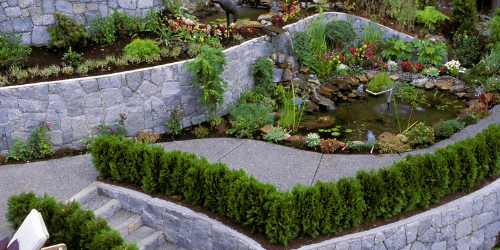Landscape design is more than just arranging plants and stones—it’s about crafting an outdoor environment that harmonizes with nature, enhances your property, and provides a serene escape. Whether you have a sprawling backyard or a cozy balcony, thoughtful landscape design can transform any space into an inviting oasis. In this comprehensive blog post, we’ll delve into the art and science of landscape design, exploring key principles, practical tips, and inspiring ideas.
Effective landscape design balances aesthetics, functionality, and sustainability. By understanding the elements that shape outdoor spaces, you can create a harmonious and visually pleasing environment that suits your lifestyle.
Understanding Your Landscape
Assessing Your Space
Observing how sunlight moves across your yard throughout the day is crucial for understanding which areas receive full sun, partial shade, or full shade, helping you select the right plants for each location. Consider the soil type in your yard, as different plants thrive in various soil conditions, such as sandy, clayey, or loamy soils. Additionally, choose plants that can withstand your local climate, considering factors like temperature fluctuations, rainfall patterns, and seasonal changes. Take into account the topography of your land—is it flat, sloped, or hilly? This will influence factors such as drainage, erosion, and microclimates, impacting plant selection and garden design decisions.
Defining Zones
Designate an entertainment area in your yard, where you can host gatherings, share meals, and create lasting memories with friends and family. Create a quiet retreat, a cozy corner where you can unwind, read a book, or enjoy moments of solitude amidst the beauty of nature. Dedicate a play zone for kids and pets to frolic and play freely, providing them with a safe and enjoyable space to expend their energy. Consider cultivating a vegetable garden if you have a green thumb, allowing you to grow your own fresh produce and connect with the earth through gardening.
Analyzing Existing Features
When designing your outdoor space, consider existing elements like trees, fences, and structures. Incorporate them into your design to preserve the natural beauty and integrity of your landscape. Work around these features to create a cohesive and harmonious layout that maximizes their potential. Utilize trees for shade, privacy, and aesthetic appeal, enhancing the overall atmosphere of your yard. Integrate fences and structures into your plan to define boundaries, add visual interest, and create functional spaces.
Design Principles
Balance
Balance visual weight by distributing elements evenly. Symmetrical balance achieves harmony by mirroring identical features on both sides, creating a sense of order and stability in the design. This approach often lends a formal and traditional aesthetic to the space, with balanced proportions and a cohesive appearance. In contrast, asymmetrical balance achieves equilibrium with dissimilar elements, relying on visual weight and contrast to create interest and harmony. This approach allows for more flexibility and creativity in design, with unique arrangements that challenge traditional notions of balance.
Unity
Cohesion is established through the repetition of colors, shapes, or materials, creating a sense of harmony and continuity throughout the design. By repeating these elements, a unified visual language is developed, enhancing the overall aesthetic appeal of the space. Unity ties together diverse elements, providing a cohesive framework that guides the viewer’s eye and creates a sense of completeness. Through careful consideration of repetition and unity, a harmonious and visually pleasing design is achieved, reflecting a thoughtful and intentional approach to landscape composition.
Scale and Proportion
When planning your landscape, take into account the size of plants, pathways, and structures to ensure a balanced and harmonious design. Avoid overwhelming or undersized elements that disrupt the visual flow and functionality of the space. Choose plants, pathways, and structures that are proportionate to the overall scale of the landscape, creating a sense of coherence and balance. By carefully considering size in your design, you can create an inviting and well-proportioned outdoor environment that feels both spacious and intimate.
Plant Selection and Placement
Native Plants
Opt for native plants in your landscape design as they are naturally adapted to your region’s climate and soil conditions, requiring minimal maintenance once established. By selecting native species, you can create a resilient and sustainable garden that thrives without excessive watering, fertilization, or pest control. Native plants also provide essential habitat and food sources for local wildlife, promoting biodiversity and ecological balance. Incorporating native species into your landscape not only reduces maintenance efforts but also contributes to the health and vitality of your ecosystem.
Layering Plants
In your garden design, consider incorporating different layers to maximize space and diversity. The canopy layer comprises tall trees and large shrubs, providing shade and structure to the landscape. Beneath the canopy lies the understory layer, characterized by smaller shrubs and perennials that thrive in partial shade. Finally, the groundcover layer consists of low-growing plants that spread across the soil surface, filling in gaps and suppressing weeds. By incorporating these layers, you can create a dynamic and layered garden that maximizes biodiversity and visual interest.
Focal Points
Enhance the visual appeal of your outdoor space by strategically placing eye-catching elements such as sculptures, water features, or flowering trees. These focal points add interest and personality to the landscape, drawing the eye and creating points of visual interest. Sculptures can serve as artistic accents, adding a sense of elegance and sophistication to the garden. Water features, such as fountains or ponds, create a sense of tranquility and serenity, while also attracting birds and wildlife. Flowering trees provide seasonal beauty with their blossoms and foliage, adding color and fragrance to the garden.
Hardscaping and Materials
Paths and Walkways
Create inviting pathways in your garden by using materials such as gravel, pavers, or flagstone. These materials offer durability, versatility, and aesthetic appeal, enhancing the overall design of your outdoor space. Gravel paths provide a rustic and natural look, blending seamlessly with the surrounding landscape. Pavers offer a clean and uniform appearance, perfect for contemporary or formal garden designs. Flagstone paths exude charm and character with their irregular shapes and textures, adding a touch of whimsy to the garden.
Patios and Decks
Design outdoor living spaces that are both functional and durable by selecting high-quality materials suited for outdoor use. Consider materials such as weather-resistant wood, stone, concrete, or metal that can withstand exposure to the elements. These materials not only provide longevity but also contribute to the aesthetic appeal of the space. Create seating areas with comfortable and weatherproof furniture, such as teak or resin wicker, ensuring they can withstand sun, rain, and temperature fluctuations. Incorporate features like fire pits, outdoor kitchens, or pergolas constructed from durable materials to enhance functionality and comfort.
Retaining Walls and Edging
Define garden beds and prevent erosion by strategically placing walls and edging materials. These features not only add structure and organization to your garden but also help retain soil and prevent runoff. Construct retaining walls using materials such as stone, brick, or timber to create terraced garden beds, especially on sloped terrain. Additionally, use durable edging materials like metal, plastic, or concrete to delineate borders and prevent soil erosion along pathways and flower beds. By incorporating well-placed walls and edging into your landscape design, you can maintain the integrity of your garden beds while enhancing their visual appeal and functionality.
Sustainability and Maintenance
Water Efficiency
Optimize water usage in your garden by installing drip irrigation systems and rainwater collection systems. Drip irrigation delivers water directly to the base of plants, minimizing evaporation and runoff while ensuring efficient watering. This method conserves water and promotes healthier plant growth by providing consistent moisture to the roots. Additionally, collect rainwater from rooftops or paved surfaces using rain barrels or cisterns. This harvested water can then be used for irrigation, reducing reliance on municipal water sources and lowering utility costs.
Low-Maintenance Plants
Choose drought-tolerant plant varieties for your garden to conserve water and reduce maintenance requirements. These plants have adapted to survive in arid conditions and require minimal watering once established. Opting for drought-tolerant varieties not only conserves water but also reduces the need for fertilizers and pesticides, promoting a more environmentally friendly garden. Additionally, these plants often exhibit resilience to heat and soil conditions, making them well-suited for various landscapes and climates.
Seasonal Interest
Create a garden that maintains its beauty throughout the year by planning for seasonal blooms and incorporating evergreen plants. Select a variety of plants that bloom at different times of the year, ensuring continuous color and interest in your garden. Additionally, incorporate evergreen trees, shrubs, and groundcovers to provide structure and texture during the winter months when other plants may be dormant.
Answering Common Questions
Q1 How often should I water my landscape?
A1 It depends on factors like soil type, weather, and plant species. Monitor moisture levels and adjust accordingly.
Q2 Can I DIY my landscape design?
A2 Absolutely! Start with research, sketch your ideas, and consider seeking professional advice if needed.
Q3 What’s the impact of landscape lighting?
A3 Proper lighting enhances safety, extends outdoor enjoyment, and highlights key features.
Seeking Expert Advice
While this blog post provides valuable insights, consulting a landscape designer or horticulturist can elevate your project. They’ll tailor recommendations to your specific needs and vision.
Conclusion : Landscape design is an ongoing journey
In conclusion, creating a well-designed and sustainable garden requires thoughtful consideration of various factors such as plant selection, water management, and seasonal interest. By opting for drought-tolerant varieties, implementing drip irrigation systems, and collecting rainwater, you can conserve water and reduce maintenance while promoting a healthy and thriving garden ecosystem. Furthermore, incorporating elements like evergreen plants and seasonal blooms ensures year-round beauty and interest in your outdoor space. By embracing these principles and practices, you can create a garden that not only enhances the beauty of your home but also contributes to a healthier and more sustainable environment for generations to come.
For more information and personalized guidance, visit us at Tailor Made Contracting is here to provide you with exceptional landscape design services that transform your outdoor space into a work of art. Whether you’re dreaming of a lush garden, a tranquil patio, or a vibrant play area, we’ll bring your vision to life. Contact us today and let’s create something extraordinary together!







